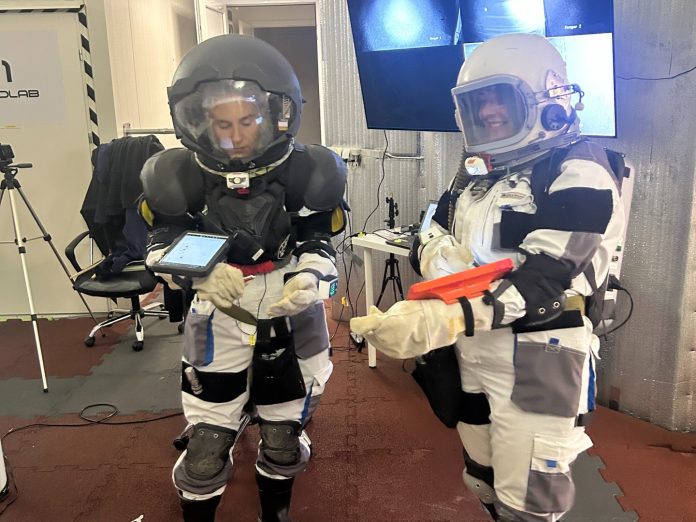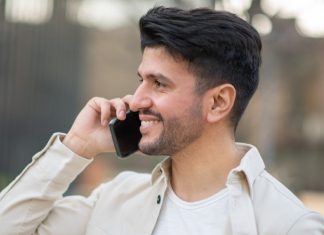Domina Stamas is no stranger to out-of-this-world experiences.
The physics and astronomy teacher at Westlake Charter School in Natomas was among 28 other teachers nationwide who were selected for NASA’s Airborne Astronomy Ambassadors Training Program in 2021 to enhance STEM education and engagement in schools.
 Domina Stamas is a physics and astronomy teacher at Westlake Charter School in Natomas. She recently returned from a two-week simulated moon mission in Poland as part of The World’s Biggest Analog Project.Sarit Laschinsky/CapRadio
Domina Stamas is a physics and astronomy teacher at Westlake Charter School in Natomas. She recently returned from a two-week simulated moon mission in Poland as part of The World’s Biggest Analog Project.Sarit Laschinsky/CapRadio
As part of that program, Stamas took flight aboard NASA’s Stratospheric Observatory For Infrared Astronomy (SOFIA), a 747 jumbo jet modified to carry an airborne telescope. She is also the founder of the Analogue Crew Education (ACE) Project, which aims to connect students to real-time analog space missions and boost interest in the space industry.
Stamas herself recently participated in one of these analogs. She spent two weeks in isolation at the LunAres Research Station in Piła, Poland as part of a six-person crew, simulating life on the moon.
The effort was part of The World’s Biggest Analog. The project included 16 habitats across four continents, simulating living on the moon and Mars, and was described as the largest proof of concept space simulation mission of its kind.
Stamas spoke with Insight Host Vicki Gonzalez on the heels of returning from Europe about the expedition, and how she hopes her work will help both real-life astronauts and inspire students in her classroom and around the world.
This interview has been edited for length and clarity.
Interview highlights
Did you always want to dive into physics and astronomy while you were growing up?
Not really. I actually didn’t have a lot of people supporting that route. I was in the young astronaut program when I was in the sixth grade at Golden Empire here in Sacramento… I still have my membership card. When you tell people you want to be an astronaut, it kind of gets laughed at a little bit… so it definitely was something that was put off to the side. It wasn’t until I got older, when I had people supporting those ideas [such] as women as physicists and astronomy, where I started to fuel my own passion along with my students.
This isn’t your first space exploration mission. Back in 2021 you were among a select group of teachers that were selected to be part of NASA’s Airborne Astronomy Ambassadors training program, and you flew with the SOFIA Telescope. How did all of these partnerships begin?
You know, it all started at Space Camp for Educators. I said this has always been an interest and I thought, “let me go to Space Camp for Educators.” If you are an adult out there and you want to go to Space Camp, you can still go do it: it’s not just for kids. That was actually my first analog, that was my first time simulating life on the moon or in space. And in that program I was introduced to SOFIA… I was introduced to all of these programs that support students in their dream to be astronauts.
You’ve got to let everybody know that there is a place for them in space, no matter what they’re interested in.
Let’s fast forward to your recent adventure. What is an analog astronaut mission?
Essentially all of the data that supports the astronauts now at NASA comes from people who have been in situations that they learn from. The astronauts have to get their training from somewhere. And so all [the analog astronaut mission] does, it just simulates either a couple weeks, a month, one mission was a year-long mission. What are the limits of the human mind, the human physical capabilities, and what can we learn from that?
This particular analog was really unique because it was the first time that so many analogs got together and simulated one mission at the same time. We had habitats from all over the world doing the same experiments, the same research, and collectively gathering data all at once.
You were part of The World’s Biggest Analog. What went into being selected for this role?
I went through the beginning selection phase. They asked questions like, what could you contribute to your team? What kind of survival things have you done such as backpacking and traveling, [or] being in the wilderness. Then we did our online training that lasted about three months… just getting to know human factors, what kind of exercises you should be doing to prepare. And then you get together with your crew.
We got to select which habitats we wanted, we got to rank them. LunAres was my top pick, and I applied to that and interviewed with them. The habitats then select who they want on their mission and LunAres chose me and my other crew members.
 The LunAres crew outside of the front of the hangar/bunker at an old airport in Pila, Poland. The all-female crew was from the US, Canada, and Spain.Courtesy of Domina Stamas
The LunAres crew outside of the front of the hangar/bunker at an old airport in Pila, Poland. The all-female crew was from the US, Canada, and Spain.Courtesy of Domina Stamas
Why did you select the moon as your analog environment?
It was the only habitat where you are actually confined into a small space. There was one other one, Hydronaut, that’s actually an even smaller one… like a tiny submarine that three people lived in simulating the space station. I knew I couldn’t do that one, so I chose LunAres because of the challenges that I could potentially be facing.
The other ones were simulating Mars and they were in more open spaces. They would have to still put on suits to step outside, but they still got to see the sun [and] the landscape. We did not see the sun for two full weeks.
What did you learn about potentially living on the moon?
 Domina Stamas drills into a boulder as part of her EVA or moonwalk. She had to collect a lunar geological soil sample.Courtesy of Domina Stamas
Domina Stamas drills into a boulder as part of her EVA or moonwalk. She had to collect a lunar geological soil sample.Courtesy of Domina Stamas
The way this facility’s set up, they took care of us very well… they did our schedule for us, they set up our experiments. That’s how NASA does it too. They try to relieve a lot of the workload for the astronauts so they can focus on the ultimate objective, either the experiments or the work that they’re doing.
This particular facility allowed for us just to focus on crew dynamics, our EVAs… which is a moonwalk. When we stepped out into the moonyard we had to wear suits. I learned that having a good upper level to look out for you, really allows for you to do your job. I think that’s in any job, any group. If you take care of your people, they are going to perform at their maximum… that’s what we ended up doing.
Did you ever get cabin fever?
A couple of the crew members were like, “this is nothing.” For me, I would say the sleep schedule kind of threw me off. There were moments where I was like, “am I getting cabin fever?” The two weeks to me were great to find your boundary. I wish that it were slightly longer to push the boundary. I really was looking for that challenge. Just when things started getting good, I had to step out into the real world.
This research went worldwide, thousands of students and teachers worked alongside crews like yours. How did all of that work?
I organized that. I’ve had my eyes set on analog missions for over 10 years now. I do a lot of teacher stuff around space exploration, and there’s never been anything that’s been around analog missions with teachers. When I was selected my main goal was to engage with my own students, and as I was building the curriculum I thought, “wait a minute… I could be doing this with any teacher.”
I put a call out to teachers and 38 educators from around the world signed up, about 3,000 students. And what came from that was so inspiring, I was blown away. There were teachers that were running their own analogs overnight. They got astronaut costumes for their students, they were making them wear helmets to go out of the classroom. They were running their own simulations and, yes, they did experiments along with us.
The way I set it up was, here’s the experiment that I’m going to be doing in my analog. Hey students, why don’t you do the same thing and let’s compare the data? I learned in my mission that it was really just the cool things of dressing up, putting puzzles together and learning the different types of exercises… it was really more collectively of what we were doing in the simulation than the actual experiments themselves.
And to me, that piece right there opens up way more doors for inspiration. If you are interested in psychology, there’s a place for you in space. If you are interested in botany, there’s a place for you in space.
CapRadio provides a trusted source of news because of you. As a nonprofit organization, donations from people like you sustain the journalism that allows us to discover stories that are important to our audience. If you believe in what we do and support our mission, please donate today.







